Blogging is one of the easiest and most affordable ways to start a business online. If you want to know how to start a blog and make money, there are a few things you need to do.
In this blog post, we will walk you through the 12 steps necessary to start a successful blog and make money in 2022.
The following topics are in this step-by-step guide:
1. How to start a blog and make money – generate a blog idea
3. Get your domain name registered
5. Determine the theme and design layout for your blog
6. Construct significant webpages
8. Create your first post for your blog
9. Establish a blog publishing schedule
10. Create an email marketing list for your business
11. Begin promoting your blog website
12. Start earning money with your blog site
Disclosure: Some of the links in this article may be affiliate links. If you click on any of them and make a purchase, we may receive a commission at no extra cost to you.
Want to get started right away? Click here and sign up for Bluehost and start your blog today.

What is a Blog?
A blog is a frequently updated website that publishes new content in an informal or conversational style to attract reader.
Blogs can be a great way to express your views on various topics.
They’re an excellent source of information, which can make money for you.
So, if you’re ready to take the plunge and learn how to establish a blog that has the potential to develop into a source of actual money online, then let’s get started with this guide.
Step 1. How To Start A Blog And Make Money – Generate A Blog Idea
The first step to starting a successful blog is to generate a great idea for your blog. This will be the focus of your content and will help you attract readers who are interested in what you have to say.
One thing you can do is to look for inspiration in other blogs that you enjoy reading. If you find a particular blog post or series that you really enjoy, try to brainstorm ways that you could put your own spin on it.
Alternatively, you can also look for inspiration in the news or on social media. If there’s something happening in the world that you’re passionate about, consider how you could discuss it on your blog.
Another great way to generate ideas for your blog is to think about what topics you’re already knowledgeable about. If there are certain topics that you feel like you could write about in your sleep, those could make for great blog posts.
Alternatively, if there are topics that you’re interested in learning more about, consider doing some research and then writing about what you’ve learned on your blog.
The niche of your blog is the general subject matter on which you will center your material.
Here are some very popular blog niches you can consider.
• Travel
• Fitness
• Food
• Freelancing
• Fashion
• Technology
• Personal Finance
• Digital Marketing
Step 2. Choose A Blogging Platform

Once you have a great idea for your blog, it’s time to choose a blogging platform to actually get your blog on the internet.
There are many different blogging platforms to choose from, but the most popular is WordPress.org.
We recommend using Bluehost as the hosting company for your WordPress (.org) platform.
Why is it important to use WordPress as your blogging platform?
– WordPress.org is an open source software that is free to use.
– It is the most popular blogging platform on the internet.
– It is very easy to use.
– It gives you full control and ownership of your blog. This includes all the materials you publish on platform.
– It has a huge community of users who can help you with any questions you have.
– It is constantly being updated with new features.
– It is very customizable and there are thousands of themes and plugins available.
– It is SEO friendly, which means your blog will be more likely to show up in search engine results.
– It is mobile friendly, which means your blog will look great on all devices.
– It is secure and has a team of dedicated security experts who regularly update the software to keep it secure.
– It is easy to extend with plugins and there are thousands of plugins available for all kinds of different purposes.
– Aside from that, the possibilities for monetization of your blog are nearly limitless.
We again recommend you use Bluehost (an overall best hosting service), as the hosting company for your WordPress platform.
Other than WordPress blogging platform, there are many other options available for you to use when starting your blog.
Some of them charge a fee, while others are free of charge.
Medium, Weebly, Blogger, Wix and Squarespace are just a few of the free options that are available.
But be aware that free blogging platforms typically impose a vast number of restrictions. For this reason, we do not encourage using free blogging platforms, despite the fact that the possibility of starting a blog without spending any money may at first seem enticing.
Why Free Blogging Platforms Aren’t the Best Option for You
The following are some disadvantages of utilizing a free blogging platform to create your blog website:
• You can’t have your own domain name. You will have a URL that shows like this “yourblog.medium.com” to customers. This is unattractive and unprofessional and is not personalized to you at all.
• Your blog will not be a source of income for you.
The free blogging platform will be in charge of managing your site’s advertising rather than you. It is impossible for you to influence the ads promoted.
Advertisement placement on your website is also out of your hands. To add insult to injury, you will not be allowed to utilize third-party advertising networks on your own.
• Regardless of what you may believe, legally you don’t own your blog while you maintain it on a free platform. It is possible that your website could be removed off the internet by your service provider for any number of reasons.
If you’re hoping to make money from your blog, it’s not hard to see why a free platform isn’t the ideal option.
What Makes a Hosting Company with WordPress Platform a Better Option?
To answer this question let’s talk a little about WordPress.org with a hosting provider.
Your content will be owned by you and no-one else.
Over a third of all websites on the internet are powered by WordPress.org’s platform with a hosting provider.
You have complete control over the design of your website. Additionally, there are a wide range of plugins and other resources to help you expand the possibilities of your site.
It’s also possible to make money from your blog site in a variety of ways.
When it comes to blogging, WordPress platform with a hosting company is the only option that provides the advantages listed above.
Step 3. Get Your Domain Name Registered
The next step is to register a domain name for your blog. Your domain name is how people will find your blog online, so it’s important to choose a name that is easy to remember and relevant to your topic.
Making an effective domain name is as simple as keeping it short and not using numbers or special characters, but also including widely searched keywords.
If your blog is going to have a specific focus, you’ll want to include that focus into the domain name in some way.
Once you have settled on a domain name, you can register it through Bluehost’s web hosting service or a domain name registrar such as Hover.
You can use the Hover domain checker to see if the name you’ve selected is available.
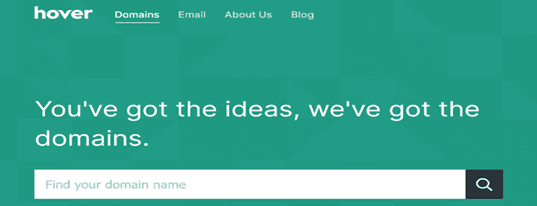
It is possible to choose a different domain name if your first choice is unavailable.
Some other providers offer a free website domain name for a year if you sign up for their website plan. They
include:
Dreamhost
Hostinger
Greengeeks
Bluehost
Step 4. Get Web Hosting
Once you have registered your domain name, you will need to set up web hosting for your blog. Web hosting is how your website will be accessible to readers on the internet.
The host is responsible for ensuring that your blog may be accessed by anyone who has a link to it or knows your URL.
Hosting a website is a lot like having a house. As soon as someone visits your blog (by typing in your URL), they can see what you have to offer.
With a high-quality hosting company like Bluehost, you may get web hosting for a very modest monthly fee of $2.95.
One of the most significant expenditures you can make when starting a blog is to use a reputable hosting company.
Your domain name, blog hosting (also known as web hosting), and blogging software are all you’ll need to get started with your blog.
In a good way, these products are usually bundled together into a single package.
When it comes to purchasing your domain name and hosting, Bluehost is the best option:
• They will install WordPress for free and automatically
• They provide dependable web hosting that WordPress has recommended since the blogging platform’s inception in 2005
• They currently host over 2 million websites for free
• They will protect your unique domain name by registering it for free and registering it in their system
• They provide round-the-clock customer service by phone or online chat
1. You can begin by clicking on this link, which will open a new tab and take you to the WordPress hosting page shown below.
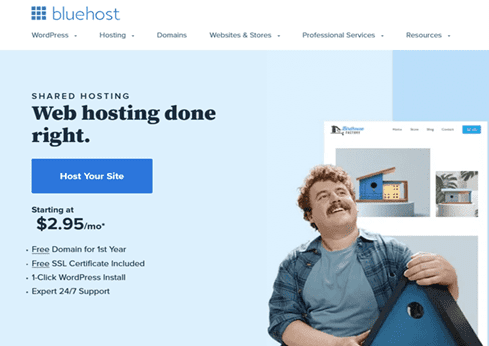
2. Click on “Host Your Site,” which will lead you to the shared hosting page where you can select “Get started” after examining the plan options.
Through this link you can choose from one of the following options: Basic, Plus, Choice Plus or Pro.
We recommend the “Choice Plus” plan above the “Basic” plan because of the added features. You’ll also get a year of free automated backup, as well as limitless websites, SSD storage, and free privacy for your domain name.
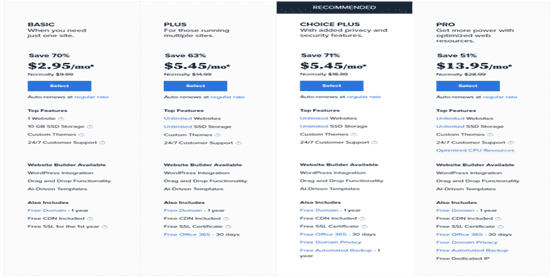
3. Once you have chosen a plan, you will be taken to the next screen. Alternatively, you can select the “I’ll build my domain later” option if you haven’t yet decided on a domain name for your website.
If people want to access your website in the future, they will type in your domain, which is the Uniform Resource Locator (URL), you selected into their web browser.
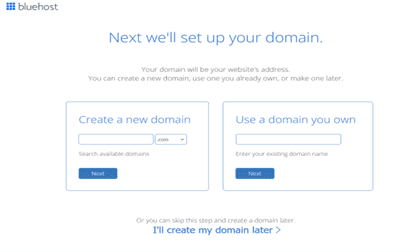
4. To proceed to the following page, click next once you’ve created or later decided to create a domain name.
Your “Account Information” will be requested here. Selecting your “Package Information” is also an option. It is possible to purchase a 12- or 36-month subscription for either $2.95 or $4.95 each month.
5. After that, if you would like to, you can select “Package Extras.” To learn more about each of these goods, simply click on “More Information.”
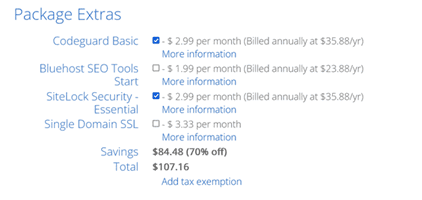
6. Next, you’ll need to input your credit card details.
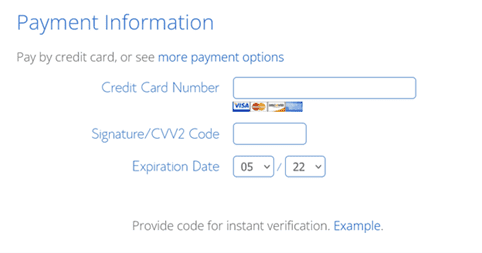
7. Bluehost will ask that you read and confirm that you understand their Terms of Service, Cancellation Policy and Privacy Notice before completing the registration process. Click “Submit” after you check the box.
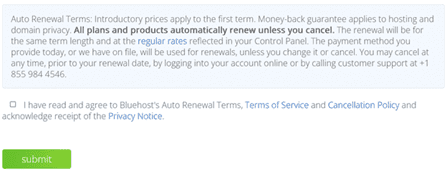
8. In this step, you will be asked to create a username and password for your account.
Logging onto Bluehost and managing both your website and account information will require these information.
9. Bluehost will take you through an informal survey so that they can learn more about your individual needs.
You can either answer all of these questions or skip to the next step by clicking “Skip this Step” at the bottom.
Note: New users should answer the questions in order to improve your onboarding process.
10. Choosing a theme for your site is the next step, which you can do once you’ve completed Step #9.
Use one of the available free themes to get by for the time being.
You can easily alter the theme at a later date if you so desire.
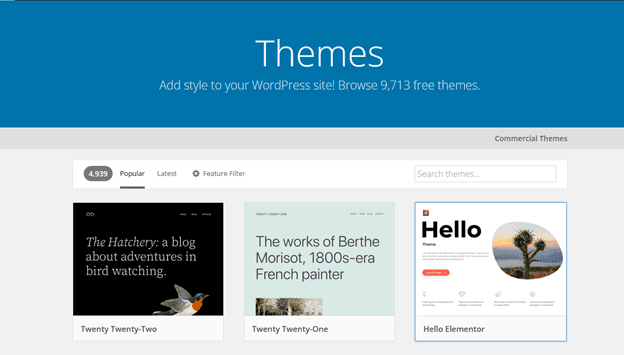
11. After that, you’ll be redirected to WordPress’s administrator panel, which serves as the platform’s back-end.
This is where you’ll be able to manage your website.
You have complete control over when and how you want to add new pages and articles. However, you must click the “Launch Your Site” blue button when you are ready.
You’d see something like this in your admin panel.
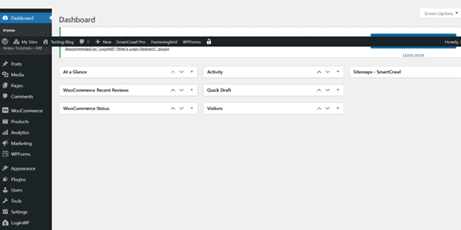
12. Finally, your blog is up and running after this final step. It’s as simple as launching a browser and entering your domain’s URL. You’ll be able to view your website as soon as you’re done.
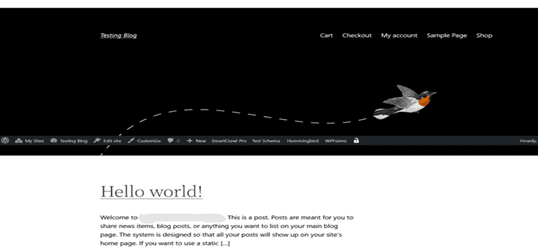
Just open a browser, type in the URL of your new website, followed by /wp-admin, and log in to learn how to make changes.
You’ll learn how to make modifications to your new website in the next two sections of this article, steps 5 and 6 of how to start a blog and make money.
Step 5. Determine The Theme and Design Layout for Your Blog
The next step is to determine the overall theme and design layout for your blog. This includes choosing a color scheme, font, and header image.
You can either create your own design or use a pre-made theme. If you’re not sure where to start, we recommend Divi Elegant Themes.
Divi has fantastic themes. All of our websites utilize this vendor, and we’ve never been let down by their services.
Choosing a theme for your blog is an important decision to make. The theme you choose will have a significant impact on the look and feel of your website, so make sure it’s one that you’re proud of.
When it comes to creating an effective visual representation of your message, where do you begin?
The following characteristics are things you want to look for to make a wonderful blog theme:
• A design that adapts to the size and resolution of the device being seen.
• Pre-designed templates that make it easy to establish a professional-looking blog.
• A wide range of options for customizing your site’s design.
• WordPress plugins are included in this package.
• Your site will quickly load thanks to a lightweight and speedy codebase.
The look and feel of your website’s front end is referred to as its “theme.” The software you use has a significant impact on this. You can think of your WordPress theme as the furniture, and your WordPress design as the way you adorn your site.
The switcher in the Appearance menu lets you swap out the WordPress default theme with a custom one.
You can choose from a large range of themes, including free and premium options. However, no matter how many options you have, there will always be some limitations with the free choices.
Several free WordPress themes, for example, have been found to include potentially harmful malware that could harm your website. This is so because, as an open source platform, anyone can submit themes to WordPress.
Free themes also, are often simple to customize and exhibit an unprofessional appeal. If you decide to purchase a premium theme rather than a free one for your website, you’ll benefit from the following advantages:
Using a Premium WordPress Theme Has Advantages
1. Aside from the fact that Google prefers websites that are quick to load, you have a wide variety of templates to choose from
2. The templates are easy to customize so that you can make your blog look exactly the way that you want
3. You also get full support if you have any issues or questions
4. Premium WordPress themes are updated on a regular basis
We prefer Elegant Themes’ Divi theme for these reasons outlined above.

Divi offers a wide range of excellent blog themes for a reasonable price to its customers.
Some of the best themes for novice bloggers can be found at the site. Each of the themes has a unique layout and a wide range of features and capabilities to offer.
Using one of these themes, you may create an amazing blog that speaks to your individual audience as well as the niche to which you belong.
Here are eight of the most useful features of the Divi theme for your blog:
1. Divi theme is incredibly versatile and can be used on any style of site.
2. It’s extremely user-friendly, even for novices.
3. Divi has a page builder that makes it simple to design bespoke layouts.
4. There are over 1900 readymade layouts available for you to start customizing your blog right away.
5. Divi is mobile-friendly and looks amazing on all devices, including tablets.
6. Your website’s style can be easily customized with the visual CSS editor included in the theme.
7. An email opt-in module, social network integration and an eCommerce module for setting up an online store are all included in Divi.
8. Plugins from other developers or your own custom code snippets can be used to enhance the Divi theme’s functionality.
Step 6. Construct Significant Webpages
It takes more than simply amazing content to have a successful blog, you will need to create some key pages.
These include an About page, a Contact page, and a Privacy Policy.
You can find templates for these pages online or hire a web designer to create them for you.
About Page: On your “about” page, explain who you are and why people should be interested in your site.
Consider including a striking title and many paragraphs of engaging text.
Consider writing a mission statement for your site.
If you want to make your page more visually appealing, you can include photographs and videos as well.
Contact Page: This is where readers can reach out to you if they have any questions or comments.
Include your contact information, such as your email and social media links.
You may also include a contact form to make it easier for your readers to reach out to you.
Privacy Policy: For any blog that collects personal information from its readers, the privacy policy is an essential page.
Privacy policies should describe what data you collect and how it is used. Ensure that you include a link to your site privacy policy.
Other Pages: The content of other blogs in the same market as yours may provide ideas for other pages you may want to build.
Look at the most essential pages of their websites to get ideas for your own.
Do you know what content is on their other pages?
Do they provide you with any specific details?
You can also get ideas for your own site’s pages by using this material as a source of inspiration.
Step 7. Design a Logo
Before you begin writing content for your new blog, you’ll need to design a logo for it first.
This will make establishing your brand and creating your website’s identity easier.
We recommend using Canva to design your logo.

You don’t have to break the bank to create a logo.
With a little time and work, you can create a stunning and significant logo.
The first step is to determine the overall concept for your logo.
Specify the colors you’d like to utilize. What type of typeface do you want to use?
While classics like black and white will never go out of style, you can also employ more vibrant colors to draw attention to your website.
If you want your blog to appear more professional, choose a serif font like Times New Roman for your site font.
Alternatively, if you want a more laid-back look for your site, consider utilizing a sans serif font like Arial.
Start sketching out ideas once you’ve got a broad notion of the style you’re looking for.
A professional-looking logo can be created using a web resource like Canva.
The name and tagline of your blog should be added once you’ve decided on a design. The font you choose and the whole design should be balanced.
It’s important to remember that your logo will display on everything from your website to social media, so it must be readable at a range of different sizes.
If you want to make your logo stand out, you can incorporate some visuals or symbols into it. If you’re launching a Christian blog, you might want to include a cross or any other religious symbol.
Save your logo in a format that may be used online and in print. Vector graphics are ideal since they can be scaled up and down without losing quality.
Following these pointers will help you design a logo for your website that truly captures the essence of your business.
Step 8. Create Your First Blog Article
No matter how experienced or novice a blogger you are, a blog writing software is a good tool to have in your arsenal.
To begin, keep in mind that a blog article should always reflect your beliefs and have a clear goal when you write it.
Before you start writing, think about the message you want to get over with your words.
Just getting started as a Blogger?
You may find that producing topics and subcategories to write about is difficult. When it comes to blogging, even seasoned writers get writer’s block from time to time.
Don’t be alarmed if this is you. For these reasons, we recommend that you make use of the writing software, named Jasper AI. This is the best blog writing software for a variety of reasons.
It contains a built-in content writing helper that may assist you in producing new blog post ideas and titles.
To ensure that your blog entries are error-free, it contains a grammar and spell checker.
It also includes a plagiarism checker to prevent copyright violations.
The algorithms and natural language processing capabilities of Jasper AI are state-of-the-art.
It’s a writing tool that uses AI and machine learning to produce text that reads and sounds like human speech. GPT-3 is the driving force behind Jasper AI natural-sounding human language writing.
Jasper AI also has additional features, like templates, post scheduling, and statistics, all help to streamline the process of generating blog articles.
As a result of these factors, we believe that Jasper AI is the finest blog post writing software available. It will make your life easier and assist you to write better content.
In creating your first blog article, keep in mind that with every piece of writing, you have the ability to make a difference in someone’s life.
Do some research on the top blogs in your field or niche before you start putting pen to paper (or fingers to keyboard).
The research can give you a better understanding of the type of writing that your target audience enjoys, as well as the key phrases and ideas that they find most compelling.
Knowing what type of content will keep your readers coming back for more is the key to excellent blog post writing.
Finally, keep in mind that quality over quantity is the most important consideration when it comes to producing blog entries.
You can save time and money by using Jasper AI writing software to create high-quality content.
How to Create Interesting Blog Posts
If you want to produce great content for your blog, you should answer the questions and concerns that your readers have.
As a blogger should avoid starting a site where you only write about your own experiences and the things that have happened to you. You want to address the concerns of your readers.
As a result, your area of expertise should be broken down into three to five distinct groups or subtopics. New categories can certainly be added at a later date.
Think about a range of titles for each of the categories you’ve chosen.
If you need help with this, you can turn to Jasper AI for assistance.
The temptation to produce new content on a daily basis can actually scare away potential readers, so don’t feel compelled to do so.
As an alternative, give attention to writing content that are truly one-of-a-kind and useful to your blog’s readers.
A Few More Tips for Blogging
While you’re working on your blog posts, keep these blogging pointers in mind:
• Make your writing personal by injecting it with emotion. People are moved by their feelings. Messages that appeal to people’s emotions are likely to get a lot of attention from your audience.
• Don’t be afraid to ask questions. Your blog posts should include questions in order to encourage a dialogue between you and your readers.
• Telling stories can hold the attention of your audience. Never be afraid to draw on your own life experiences when trying to pique the interest of your audience.
• Make sure you stick to the point of your topic. Each and every one of your posts should be assigned to a certain category.
• Incorporate relevant keywords. To increase the chances of your blog article showing up in search engine results, use a wide variety of topic keywords. This is a part of SEO (search engine optimization).
Initially, focus on including appropriate keywords in all of your posts so that search engines can route visitors to your website. This helps to get you the best outcomes.
However, this is an ever-changing area, so keep up with the latest SEO best practices in order to be relevant. As a learning tool, we recommend that you check out the vast resources Ahrefs offers.
Step 9. Make a Content Publishing Calendar for Your Website
At this point, you may be asking how frequently you should be posting your articles. A content calendar can help with this.
Your blog content calendar is an outline of what posts you’ll be writing and when. You can use a content calendar to keep track of your schedule.
A content calendar is a great way to keep your content structured. There are a few things to look for in a content calendar.
First and foremost, it must be simple to use and follow.
Second, make sure it’s adaptable in case something changes at the last minute.
Third, it should easily integrate with other content-related applications like your social media posting schedule.
Finally, it can help you produce new ideas for content.
Don’t know where to begin? Here are a few pointers to keep in mind:
1. Take a look at your long-term goals for your blog before you get started. What are your goals for this project? Are you trying to expand your audience for your business?
As soon as you’ve established your objectives, you can start thinking about the type of content that will help you get there.
2. The frequency of your posts should be determined once you’ve decided on the type of material you’ll be producing. Starting out, you can try to post once or twice a week.
You can increase your blogging frequency as you gain experience. Just make sure you’re honest with yourself about the amount of time and effort you’re willing to devote to your blog writing.
You can find content calendar templates online, so it shouldn’t be hard to find one that fits your needs.
For instance, the Google Calendar is a great choice to keep all of your content in one place and easy to find. Plus, you can use it for free.
Alternatively, if you have access to Microsoft Word or Excel, you can make your own calendar.
Step 10. Create a Mailing List for Email Marketing
You’ll want to set up an email marketing list as soon as you start writing blog posts.
Staying in touch with your readers and letting them know when new content has been released is made easier with an email list. You can set up an email marketing list following these instructions:
1. The first step is to choose an email provider. Take some time to investigate the best solution for your situation. There are a lot of options out there. There are a few things to keep in mind, such as cost, functionality, and user-friendliness.
GetResponse is a good choice, and we recommend it.

GetResponse has a number of advantages over other email marketing services, including the following:
First, they provide a wide selection of email marketing tools that may be used to build successful campaigns. To get the most out of your email marketing, you can rely on their advanced tracking and reporting features, as well as their automated email sequences and other features.
Second, their delivery is flawless. Because of this, your emails have a better chance of reaching their intended recipients.
Third, their customer service is excellent. With any inquiries or issues, they’re always available to help.
With their easy to use templates, you can set up your email campaign following these easy quick steps:

1. Make a sign-up form. This should be something that your readers can easily fill out and send to you.
You should at least ask for their name and email address.
You might also want to add optional fields for things like their city or country, for example.
2. Tell people about your sign-up page. Make sure your readers know about your sign-up form by talking about it on your blog and in your social media posts. In your email signature, you can also add a link.
3. Say hello to the new subscribers. When someone joins your list, send them a welcome email to tell them who you are and thank them for signing up.
You might want to add links to some of your best posts so that people can start reading your blog right away.
All done! If you follow these steps, you’ll be well on your way to building a successful email marketing list for your blog.
Step 11. Get Your Blog Promoted
As exciting and satisfying as it is to start a blog, promoting your site is critical if you want it to grow a following. This is an essential consideration while deciding how to start a blogging.
You can market your blog in a variety of methods, both online and offline.
Social media platforms like Facebook and Twitter allow you to post status updates or share links to blog posts with your friends and followers.
However, the first thing you should do is to tell your family and friends about your new blog.
Ask them to take a look at it and give you their views and feedback as soon as they do.
In addition, you should ask your friends and family to spread the word about your new blog by sharing it with them.
Make the most of the email marketing campaign you’ve started. Sending a link to your new site, along with a request for them to visit and read your posts, comment on them, and spread the word about your site is an option.
What matters most is to find tactics that resonate with your target audience and that fit within your time limits.
You can help your blog achieve its maximum potential by taking the appropriate strategy.
Step 12. Start Making Money from Your Blog

While making money from your blog is your end goal, you can’t expect to make money right away unless you already have a large following somewhere.
Monetization should not be your primary emphasis right now, but rather something to work towards.
You should have an idea of how you want to generate money blogging before embarking on this new journey.
To make money blogging, there are a number of ways that you can make money from your blog.
Below are some ways to monetize your blog, however, while your readership is still increasing, it will be easier to adopt some of these monetization tactics than others.
1. Sell Your Work or Services
You can start making money from your blog right away by selling your services. These can be things like blogging employment for a company, freelance writing projects, or offering your expert knowledge.
As a freelancer, you will want to market yourself efficiently. This is where starting a blog would help considerably.
As a matter of fact, you can sell any skill that you possess. If you have samples of your work, you will want to showcase them on your blog.
2. Affiliate Marketing
In affiliate marketing, a person joins an affiliate network or program and is compensated for referring individuals to buy certain products. You can make money from the comfort of your own home with this method.
For example, as soon as you sign up for an ad network such as Google AdSense, your blog readers will see adverts from this company. In the event that one of your customers clicks on one of your advertising, you will be paid a small commission.
3. Sponsored Blog Posts
If you don’t currently have a sizable readership on your blog or social media platforms, it will take some time before sponsored material becomes an option for profitability.
What is a Sponsored Post on a Website?
A sponsored blog post is a post that is created by a blogger in exchange for payment from a company or individual who has products or services to promote.
These posts are usually written in a first-person point of view and reflect the blogger’s personal opinion about the product or service.
While sponsored blog posts can be an easy way to make money from your blog, it’s important to make sure that you only agree to write about products or services that you actually believe in. Otherwise, your readers will quickly catch on and lose trust in your recommendations.
So how to start a blog and get paid through sponsored posts? There are a few things you need to do.
First, you’ll need to choose a niche or topic for your blog. Once you’ve decided on a focus, you’ll need to create interesting and engaging content that will attract readers. Finally, you’ll need to identify companies or individuals who would be interested in sponsoring your blog.
Once you’ve established yourself as a reliable source of information, you can start approaching companies and individuals about sponsoring your blog.
4. Courses That Can Be Taken Online
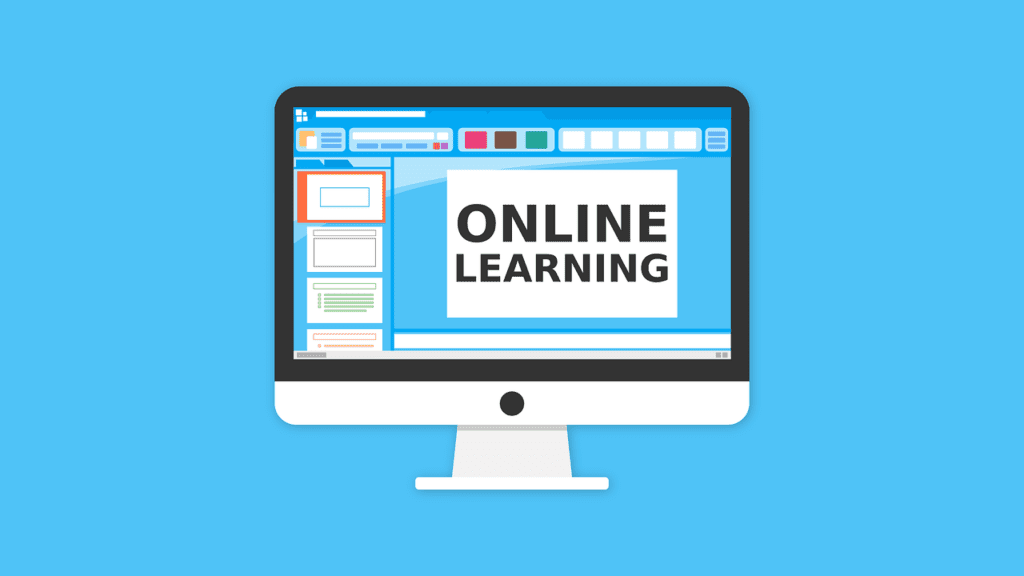
With a skill or experience that others are eagerly seeking to learn, it’s simple and inexpensive to bundle it into an online course. Clients may pay for access and learn much more quickly through an online course.
To make money from your blog through an online course, you don’t have to have a massive audience.
First, you’ll need to decide what kind of course you want to create. Do you have an expertise that you can share with others? Alternatively, is there a particular topic that you’re passionate about?
Once you’ve decided on the focus of your course, you’ll need to create high-quality content. You can do this through writing detailed and helpful articles as an example.
Finally, you’ll need to market your course and make it easy for people to find.
Once you’ve put in the work, you can start receiving payments from students all over the world. With a little bit of effort, you can soon be making money through online courses.
5. Software and Physical Products (eCommerce)
Selling a physical product or software tool to your blogging community can also help you make money. This is especially true if you start an eCommerce store selling things that correspond to the needs of your readers.
Helping the readers of your blog find solutions to the challenges they face is ultimately the most important thing you can do for them.
E-commerce, which was traditionally a labor-intensive industry, has recently emerged as a viable strategy for monetizing a blog audience thanks to the development of drop shipping and order filling systems.
In addition, you can utilize loyalty programs that reward consumers for referring their friends and family members to your company. These programs can include free trials for a period of time, discounts for new customers, gifting programs, and a variety of other options.
As you can see, as a blogger you have several options for monetizing your work.
You’ll be able to monetize your blog with more ease and success if you create a strong presence in your niche and become recognized as an authority figure.
Final Thoughts on How to Start a Blog and Make Money
Starting a blog can be an extremely rewarding experience, not only because you get to share your thoughts and ideas with the world, but also because you can make money from it.
In this article, we’ve outlined the 12 steps to start your blog and make money from it.
Reminder: it’s critical to create your writing with a clear sense of purpose and meaning in mind.
Finally, don’t forget to grow your community by connecting with other bloggers and responding to comments on your pieces.
And you can keep your blog going for years to come with a little work and care, so why wait?
If this article was helpful to you, please share it with others who might benefit from it, and be sure to check out our other blog posts here.
Also, if you have any questions or comments, feel free to leave them below or send us a message. We will be glad to hear from you.






